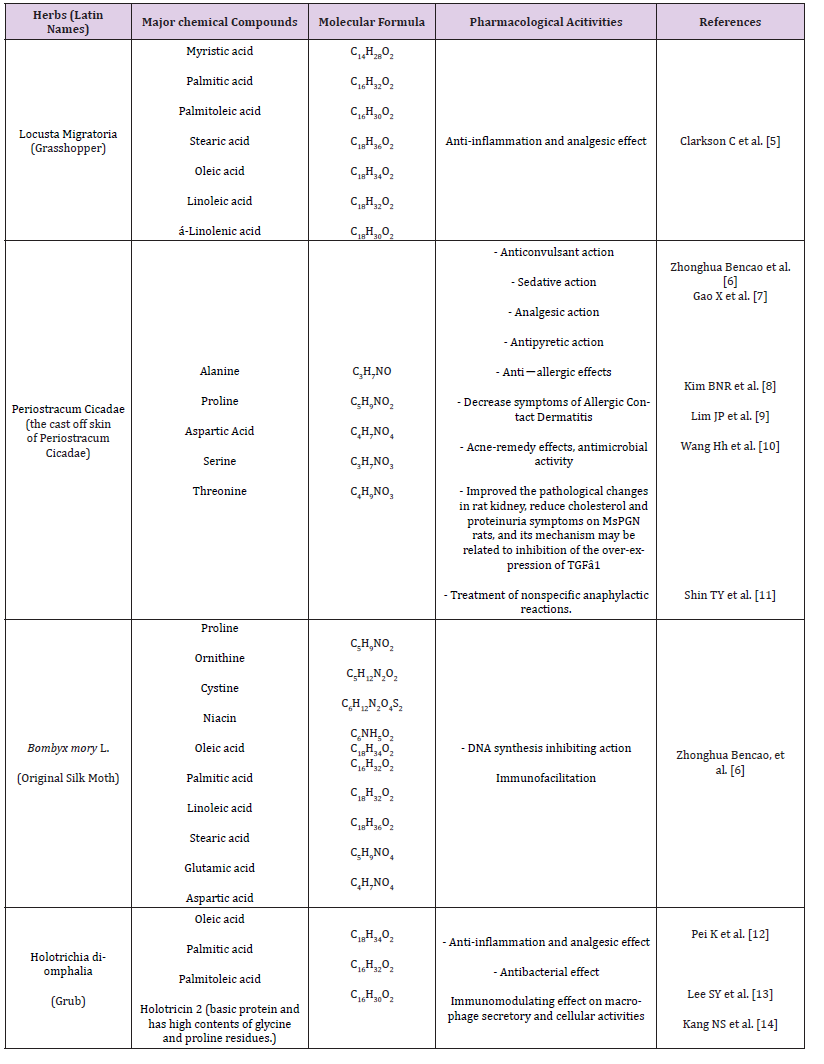The Potential Usefulness of Several Insects and Fatty Acids in Allergic Disorders
Introduction
Insect medicine is an old ancient medicinal concept that is still used in Asia. It can be understood as the traditional animal species medicines, including the dried animal bodies, secretions and processing natural products of medicinal insects. Entomotherapy is the use of insects as medicines and is an important complementary and alternative to modern therapy in many parts of the world [1]. One of the most considerable differences in the drug materials in East Asian traditional and modern scientific medicines is the use of insects [2,3]. Nutritionally, insects are high in protein and fat compared with typical dietary items like fruit and vegetation. In small quantities, they may serve to provide important fatty acids. It is well known that insects are not only selected based on their environmental availability, but also their nutrient composition. Insects can play a key role (in anti-inflammatory responses by inhibiting (secreting) inflammatory mediators) in the diet of many nations. Their high nutritive value is mainly determined by a high content of protein, essential fatty acids, vitamins, minerals and other bioactive substances [4].
Potential Usefulness of Fatty Acids
As shown Table 1 [5-14], the major components of medicinal insects were myristic acid, oleic acid, palmitic acid and palmitoleic acid. There are many kinds of necessary amino acids and inorganic elements for mankind in insects. As shown Table 2 [15-33], oleic acid reduces IgE binding to allergens and decreases the production of inflammatory mediators by inhibition the endothelial expression of VCAM-1, E-selectin and ICAM-1. Linoleic acid reduces bronchoalveolar inflammatory cell count and lung IL-5 levels in an animal model. Also, it reduces proinflammatory cytokines production by eosinophils and bronchial epithelial cells. Palmitoleic acid promotes anti-inflammatory effects in macrophages exposed to LPS. However, palmitic acid sensitizes dendritic cells resulting in augmented secretion of Th1/Th17 cytokines upon proinflammatory stimulation. n-3 PUFA may directly regulate the function of the effector cells that mediate the allergic inflammatory response. Increased n-3 PUFA preferentially modulate the Th2-cell response, there was a marked down-regulation of IL-5, IL-9, IL-13 and RANTES n-3 PUFA suppress FcεRI-mediated activation of mast cells.
Table 1:Summary of major compounds (fatty acids) identified from several kinds of medicinal insects and their biological activities.

Table 2: Summary of major fatty acids and their biological activities in the development of lung diseases like asthma or COPD.

Conclusion
Therefore, above results provide evidence about the potential usefulness of the mixture of fatty acids from medicinal insects in allergic disorders. Overall, fatty acids have various roles in the way they affect the immune system and allergic responses and no single dietary fatty acid is suitable for treating allergic disorders. It is necessary to conduct more large scale studies with relevant animal models to arrive at meaningful recommendations for various fatty acid interventions for clinical usefulness. Further scientific research will be accomplished. This issue is and will be subject of work of many researchers from different areas.
Unusual Case of Wilson’s Disease and Coexisting Autoimmune Hepatitis-https://biomedres01.blogspot.com/2021/01/unusual-case-of-wilsons-disease-and.html
More BJSTR Articles : https://biomedres01.blogspot.com


No comments:
Post a Comment
Note: Only a member of this blog may post a comment.